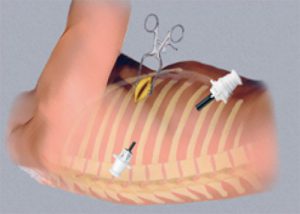
VATS (Video Assisted Thoracic Surgery):
The word surgery evokes fear in people’s hearts. This fear stems from the perception most people have of conventional surgeries, which include large incisions on the body and prolonged recovery times. However, today, due to the evolution of technology, some surgeries are minimally invasive. This means that not only is a large incision unnecessary in these surgeries but in some cases, the patient can walk out of the hospital on the same day as the procedure.
Video-assisted thoracic surgery or VATS is one such minimally invasive procedure, which helps diagnose and treat chest disorders.
What is VATS?
VATS is a type of minimally invasive surgery of chest. In this technique a small video camera called thoracoscope is inserted into the chest through a small cut to see inside and surgery is performed using special fine instrument through two or three small incisions (0.5 – 1cm). The thoracoscope transmits the image of inside of thoracic cavity onto a HD monitor. Other name of VATS are thoracoscopy, Thoracoscopic surgery or pleuroscopy.
Why is VATS done?
A number of reasons can prompt the doctor to prescribe VATS procedure for you. Here is a look at some common reasons –
• To conduct a biopsy for the diagnosis of mesothelioma, lung cancer & other cancers in the chest region, to identify infection or interstitial lung disease
• Surgery of the oesophagus
• To repair a hiatal hernia
• Surgery in the lungs for reducing lung volume or for lung cancer treatment
• To treat coughing of blood (Hemoptysis) due to fungal infection (Aspergilloma) or tuberculosis
• To conduct surgery for removal of excessive air or fluid from the region near the lungs
• To conduct surgery to prevent excessive sweating
• To remove the thymus gland
• To treat excessive GERD and acidity
• To treat hernia of Diaphragm or paralysis of diaphragm (eventration)
What are advantages of VATS?
In VATS, we make very small incisions causing very less trauma as compared to traditional “open” surgery. So, patient undergoing minimally invasive VATS procedure experience:
• Less pain after surgery
• Reduced bleeding during surgery
• Shorter operative time
• Reduced risk of infection after surgery
• Sorter hospital stay
• They recover more quickly and soon return to work (starting to earn their livelihood)
• Less incidence of long term (chronic) pain and shoulder dysfunction
• Better quality of life after VATS surgery
How to prepare for VATS?
Your doctor may ask you to undergo a few tests before the VATS procedure. These clinical tests help determine whether you are eligible for the surgery.
What to expect during VATS?
If you are undergoing VATS, it is likely that your doctor will administer general anaesthesia. You will be unconscious for the duration of the surgery. After administering the anaesthesia, the surgeon will insert a breathing tube through your throat. He/she will then make a small incision on your chest. Using specially designed instruments that contain a camera, he/she will perform the surgery.
After the procedure is complete, the surgeon will suture the area. Recovery from VATS: Due to the minimally invasive nature of the surgery, you will only need to stay at the hospital for a few days after the surgery. Post your discharge, you can go home and slowly get back to your daily life. However, you should let a family member or friend help you during this phase, because you may experience some pain from the surgery.
You can watch a video of VATS done by DR Atul Mishra at our You Tube Channel:




